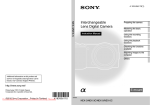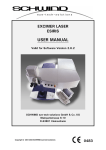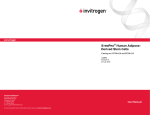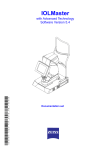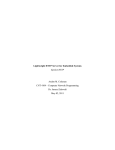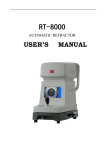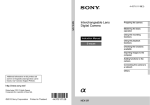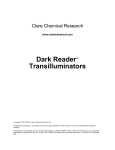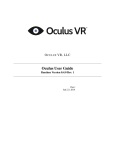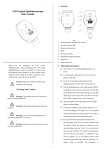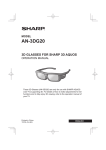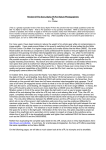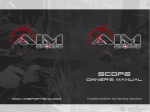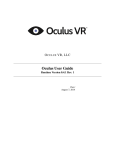Download Sample Pages
Transcript
1 2 Chapter 1: Getting Started Chapter 1: Getting Started 01_Sony NEX7_cz5.indd 2 10/17/12 5:21 PM Introduction 3 1 Introduction At the time of this writing, the Sony NEX-7 is the most advanced mirrorless camera in the Sony lineup. The camera uses the 24-megapixel sensor of the Sony A77 and A65, which makes it one of highest-resolution cameras in its class. In spite of this, the camera is remarkably small, weighing in at half the weight of the A77. Although the NEX-7 cannot be described as a pocket camera, its size and shape allows it to be easily carried everywhere. Plus, the camera’s compact size and sleek lines make it look less intimidating to a camera-shy subject (figure 1-1). Figure 1-1: The Sony NEX-7 is a compact interchangeable lens camera Unlike a digital single-lens reflex (DSLR) camera, which requires a mirror to direct light to an optical viewfinder, the Sony NEX-7 is mirrorless. Light goes directly to the sensor, which drives either an electronic viewfinder (EVF) or a rear LCD screen (figure 1-2). Both display the image and the effects of the camera settings before the photographer takes the picture, thereby ensuring that errors in white balance or exposure can be corrected before the shot is taken. In addition, the absence of a mirror makes the camera virtually vibration free when a picture is taken. In contrast, a DSLR with an optical viewfinder is prone to vibration when it rapidly lifts the mirror and slams it to a stop at the top of the mirror chamber so light can reach the sensor for exposure. The sudden impact of the mirror and the rapid 01_Sony NEX7_cz5.indd 3 10/17/12 5:21 PM 1 4 Chapter 1: Getting Started movement of the mechanical shutter’s first curtain vibrate the camera body during exposure. For high-magnification work, this movement blurs the recorded image. On some Internet forums, a few people have complained about the inferior view through an EVF compared to that of an optical viewfinder. To some extent this is true. For example, the optical finder image has a greater dynamic range, so the photographer can study details in areas of bright highlights and dark shadows. In contrast, a photographer who views through an EVF can see the highlights, but the shadowy areas may appear as impenetrable masses of black. This disadvantage is counter balanced by the view through the Sony NEX-7’s viewfinder being larger and brighter than most optical viewfinders. This is especially evident in cameras that use an APS-C sensor, which includes virtually all interchangeable lens cameras in the NEX-7 price bracket. Optical viewfinders whose apparent size matches that of the NEX-7 are found only in full-frame cameras, such as the Nikon D800 or Canon EOS 5D Mark III. Such cameras are significantly bulkier, heavier, and are more expensive than the NEX-7. An additional advantage of the EVF is evident in dim lighting where optical viewfinders become progressively dimmer as light levels drop. In contrast, an electronic viewfinder maintains its brightness, regardless of the light level. As compared to an optical viewfinder, the large, bright electronic viewfinder makes it easier to frame and compose the scene even in a dim setting. Figure 1-2: Back of Sony NEX-7 camera showing the two viewfinders For us, the advantage of using an electronic display for composing our image (on both the EVF and LCD monitor) is that it increases our success rate in obtaining technically good photographs. Errors in white balance are immediately evident, and steps can be taken to correct this before the picture is recorded. The same applies to exposure. With a real-time histogram display and a view of how a given 01_Sony NEX7_cz5.indd 4 10/17/12 5:21 PM Introduction 5 1 exposure records the subject, it is a simple matter to finely adjust the aperture or shutter speed for the best exposure. Finally, the electronic displays can provide a more precise metric for focusing. Because you can selectively enlarge portions of the image on both the EVF and LCD screens, the increased magnification ensures that you are precisely focused on your subject. This is especially critical for long telephoto work where there is little depth of field. Finally, the NEX-7 always provides an indication of depth of field. The camera displays the image at the working aperture of the lens, so you can estimate whether the background or foreground surrounding the subject is rendered sharply or blurred. In spite of its small size, the Sony NEX-7 is one of the most capable cameras in its class and can generate professional results. For example, it has one of the highest pixel counts in a compact camera, 24.3 megapixels. This means the sensor can bring in enough data so you can enlarge your pictures and still have the detail hold up. We have printed sharp 20 x 30 inch prints without any detail degradation. Movies vs. Videos What is the difference? According to dictionary definitions, a movie is a captured series of pictures in the motion picture industry, and a video is recorded onto videotape or some other recording device for the television industry. Both of these definitions ignore the camera’s role in capturing the picture. Although we would rather call moving pictures recorded on a camera a “video,” Sony has chosen to use the term “movie.” To be consistent with their terminology, we will use “movie” in reference to the recording of moving pictures with the camera. There may be some cases where industry terminology is so predominate that we will use “video,” but those will be the exceptions rather than the rule. The absence of a hinged mirror provides several advantages. Perhaps the most obvious is automatic focusing when recording movies. Although DSLRs can record movies, you have to manually lock the mirror up and use the camera’s sensor for focusing. Being mirrorless, Sony’s automatic focus system does not have this requirement. Instead, the camera is always available for taking a movie, and all that is required is pressing the movie button. Finally, an underappreciated aspect of this technology is the inclusion of an electronic first curtain shutter. When the sensor is exposed to light, the NEX-7 is virtually vibration free. Remember, the raising of its mirror and the movement of its mechanical shutter jars a DSLR. The absence of these two mechanisms ensures that the NEX-7 can remain stationary during use—an advantage for discriminating photographers who do not want to sacrifice sharpness because of camera movement. 01_Sony NEX7_cz5.indd 5 10/17/12 5:21 PM 1 6 Chapter 1: Getting Started Dual Viewing System The Sony NEX-7 has two electronic displays: an EVF with an eyepiece and the movable LCD screen on the back of the camera. Most digital camera users are familiar with the latter. Unlike some early EVFs, the viewfinder of the NEX-7 is extremely sharp with a good refresh rate. It replaces the optical viewfinder on DSLRs. There are tremendous advantages of having two electronic displays, which give the photographer lots of flexibility for framing and composing a photograph. The rear LCD screen can be held at arm’s distance and is convenient to use when the camera is mounted on a tripod. If you have to raise the camera above your head, you can tilt the LCD downward so you can aim and photograph over the heads of an intervening crowd of people. Or you can rest the camera on the ground and tilt the LCD screen upward to view and photograph a low-lying flower without having to lie down behind the camera. The EVF, which has an eyepiece, is valuable for working in ambient sunlight when the intensity overwhelms the view on the rear LCD. It is also convenient when you can’t disturb your surroundings with the light of the LCD screen, such as at a school play in a darkened auditorium. In addition, having the camera pressed up against your face helps steady the camera. To conserve battery life, the EVF and the LCD screen are designed to work sequentially. When one is on, the other is off. The viewfinder is enabled when the camera senses that something, assuming your eye, is close to the eyepiece. When you move your eye away, the viewfinder turns off and the LCD screen turns on. You have a choice of how the switch occurs; it can be done either automatically (default) or you can set the camera so that just one of the display modes is in operation. There are both advantages and drawbacks to each of the viewing displays. The Sony NEX-7 has a few differences in how the camera settings are displayed versus what you see in the viewfinder or on the LCD screen. As you use the camera and become familiar with its settings and buttons, you will develop personal choices as to which viewing system works best for you. In chapter 3 we will cover details about the LCD screen and the viewfinder and discuss how to display information on each of them. 01_Sony NEX7_cz5.indd 6 10/17/12 5:21 PM Setting Up Your New Sony NEX-7 7 1 Diopter Adjustment Dial There is one more thing you need to know about the viewfinder. It has a magnifier that needs to be focused on the screen. To the right of the eyepiece is a small wheel called the diopter adjustment dial (figure 1-3). Rotate the dial up or down until the objects in the viewfinder appear maximally sharp. If you share your camera with others, they must make sure that the viewfinder is in focus for their eyes. If you are nearsighted (myopic) and your photographer partner is farsighted (hyperopic), you will have to adjust this dial whenever the two of you use the camera. This dial ensures that the photographer, whether nearsighted or farsighted, will have a Figure 1-3: The diopter adjustment tack-sharp image in the viewfinder. dial to the right of the viewfinder Setting Up Your New Sony NEX-7 When you take your camera out of the box, you will have the following components: • Camera body: 24.3 effective megapixel Sony NEX-7 • E-mount 18–55mm zoom lens • Front and rear lens caps • Lens hood • Rechargeable InfoLithium (NP-FW50) battery • Battery charger (BC-VW1) • Shoulder/neck strap • USB cable • Body cap • Accessory shoe cap • CD-ROM with Sony software • Camera manual Make sure you have everything before you assemble your new camera. First, fully charge your battery, attach the lens, and insert a memory card on which to store your pictures and movies. When you are done, you’re ready to start. 01_Sony NEX7_cz5.indd 7 10/17/12 5:21 PM 1 8 Chapter 1: Getting Started Battery The supplied InfoLithium (NP-FW50) Lithium-ion battery should be fully charged before use. Insert the battery into the charger and plug the charger into an outlet. An LED light should begin to glow. This light provides several signals: • Steady glow: The battery is charging. • Rapid flashing (0.15 second intervals): The charging failed, and the battery may be defective. Remove the battery from the charger and reinsert it. If rapid flashing persists, replace the battery. • Slow flashing of the amber light (1.5 second intervals): Charging is not occurring, probably because of too low or too high ambient temperatures (50°F to 86°F). • Light turns off: The battery is fully charged. Completely draining a battery of its charge can damage it. Make sure you fully charge the battery before using it. You will find that the battery may not last for a full day of shooting, and a spare will come in handy. For the active photographer it is not a question of whether you will need to buy a spare battery, but when. A battery does not last forever. As you continue to use the camera, the battery will progressively hold less charge. Most people make it a general practice to purchase a spare battery when they buy a camera. We recommend that you use Sony-certified batteries because noncertified batteries will void your warranty and may ruin your camera. Why Use a Certified Battery? Buying third-party batteries is tempting because they can be less expensive. But using them is a risky proposition because Sony does not guarantee the quality of their construction. If the batteries damage your camera during its warranty period, Sony is not obligated to repair or replace your camera. Under the best conditions you may be happy with these batteries, so no harm is done. But you can also end up with a battery that may not hold as much of a charge or may drain too quickly. Or, in the worst-case scenario, the battery may damage your camera and the money saved by buying the inexpensive battery will be lost by having to repair or replace your camera. 01_Sony NEX7_cz5.indd 8 10/17/12 5:21 PM Memory Card 9 1 Memory Card You need a memory card to use with this camera. Unlike some point-and-shoot consumer cameras, there is no internal memory for storing images, so the camera will not operate without a memory card! You may already have a compatible memory card from a previous camera. You can use another camera’s memory card for your new Sony NEX-7 as long as it is an SD, SDHC, or SDXC card. If not, you will have to purchase one. But what should you buy? The NEX-7 uses a Secure Digital (SD) memory card. These cards, about the size of a postage stamp, come in many varieties with various memory capacities and data transfer speeds. They are designated as SD, SDHC, or SDXC, which refer to the card’s maximum memory capacity. Don’t be too concerned about these designations because it is more important to know the memory capacity of the card (see the “Memory Cards” box) and its class rating. You can use any manufacturer’s SD, SDHC, or SDXC memory card of Class 10 or faster for both still pictures and movies. Sony currently sells an SDHC Class 10 card that holds 32 gigabytes (GB) of data for about $100. But you can opt for a 16 GB card (about $60) or an 8 GB card (about $40) instead. The SDXC cards are the most expensive and can have the highest memory rating. We find the 32 GB cards to be an economical choice and are perfect for a day of shooting or movie taking. A potential problem with high-capacity memory cards is that a failure in the card can result in a tremendous loss of data. For this reason, many photographers use several smaller-capacity memory cards so that if one goes bad, the loss of pictures is limited to that one card. Memory cards are categorized into classes (2, 4, 6, 8, and 10); the higher the class, the faster the card can receive and record data. The size and class of the memory card you buy depends on how you will use the camera and how you plan to maintain the stored pictures and movies. If you plan to take a lot of movies, you will need a lot of memory with a fast speed rating. Generally, you should select a Class 10 card if you need to record movies in AVCHD format. We recommend using at least 8 GB to allow for enough storage space. If you are going to take mainly still photos, 4 GB should suffice. Instead of using an SD card, you may decide to use a Sony memory stick card. They are not as common, and for a given memory capacity they tend to be a bit more expensive. Note that if you want to record both still pictures and movies on a Memory Stick PRO Duo, it must be the Mark 2 version. The Memory Stick PRO-HG Duo records still pictures and movies. 01_Sony NEX7_cz5.indd 9 10/17/12 5:21 PM 1 10 Chapter 1: Getting Started At the end of each shooting day, get in the habit of downloading the images from your camera to your computer. After the files are downloaded, erase the images on the card by using the camera’s Format command. This allows you to start fresh the next day, minimizing the risk of running out of memory. Although you can connect your camera to your computer with a cable and transfer the stored files directly, you can also download the files with a card reader. Remove the memory card from the camera and insert it into a card reader that is connected directly to your computer with a USB cable. Many people keep several memory cards for those occasions when they will be doing a lot of recording and will not be able to download the contents to a computer. It’s important to note that memory cards can fail, and having a backup will ensure that you can resume shooting if your primary card fails. For our own photography, we tend to use 32 GB Class 10 cards because they provide plenty of space and speed to accommodate a day’s worth of shooting and movie recording. Memory Cards The Sony NEX-7 user manual tells you approximately how many pictures or movies you can record on a memory card. The space used depends on the detail within the images and the file type. Memory card criteria: • SD memory card (8 MB to 2 GB) • SDHC memory card (4 GB to 32 GB) • SDXC memory card (32 GB to 2 TB) Additional information: • An SDHC memory card can be used with equipment that’s compatible with the SDHC or SDXC memory cards. • An SDXC memory card can be used only with equipment that’s compatible with the SDXC memory card. 01_Sony NEX7_cz5.indd 10 10/17/12 5:21 PM Assembling the Camera 11 1 Assembling the Camera The battery and memory card sit next to each other and share a compartment on the base of the camera. When you invert the camera, you will see the cover with a sliding rectangular switch. Slide the switch to open the compartment, and slide the fully charged battery in the direction of the arrow painted on its side. The battery can be fully seated only one way; a set of ridges surrounding the contacts helps you orient the battery properly. You will hear a solid click when it is properly seated. You can now close the battery cover. To remove the battery, open the compartment to expose a small blue lever that blocks the removal of the battery. Push the lever to the side, and the battery will pop out. The memory card compartment is next to the battery compartment and is revealed when you open the cover. When you insert the memory card, the end with the metallic reading bars goes in first. It will lock into position with a click. To remove it, push the top of the memory card to release the lock, and the card will pop out for easy removal. If the memory card is defective or if its contacts are dirty, a NO CARD message will be displayed in the top left on the LCD screen when you turn on the camera. If this occurs, remove the memory card and reinsert it. The message should go away. If it doesn’t, the card may be defective and will have to be replaced. Next, attach the lens to the camera body. Remove the rear lens and camera body caps. Store both caps in a safe place for future use. Inserting the lens is a two-step process. There is a white bump on the barrel of the lens and a white dot on the rim of the camera body’s lens mount. Align these two indicators, insert the lens, and then rotate the lens clockwise until you feel and hear a click. The lens is now locked in position and ready to use (figure 1-4). Last but not least, attach the camera strap. It should always be secured to the camera and placed either around your neck or over your shoulder when Figure 1-4: The camera body without and with you’re carrying or using the camera. the lens, showing the white alignment dots 01_Sony NEX7_cz5.indd 11 10/17/12 5:21 PM 1 12 Chapter 1: Getting Started Protecting the Lens There are several ways to protect your camera lens against damage. The first and most obvious is to keep the lens cap on when you are not using your camera. The second is to use a lens hood when you are shooting to help keep errant objects from hitting the lens. Another benefit is that the hood increases image contrast by blocking light from the side of the lens, keeping it from entering the camera. The third way to protect your camera lens is to use an ultraviolet (UV) filter. These threaded filters can be screwed onto the lens and serve as a clear optical lens cap. Sony sells these filters, but if you know the thread diameter of your lens, you can buy other brands. The use of a UV filter is controversial. Some claim it’s a good idea, and others claim the protection is minimal and the filter degrades image quality. There is an element of truth in both viewpoints. We find inexpensive, off-brand UV filters to be problematic. Sometimes the optical quality is so bad that it does degrade performance. To avoid this, we buy and use high-quality filters made by reputable manufacturers. Filters made by Tiffen, Hoya, and B+W are good and do not degrade lens performance. You may be surprised at their expense, but considering they are optically ground, polished, coated disks of glass, their prices are reasonable. We routinely mount high-quality UV filters on our lenses. Although there is a theoretical chance of losing some image sharpness, it’s so slight that we don’t notice it. Protecting the LCD Screen Although the Sony NEX-7 LCD screen is made of a durable material, it can be scratched. This won’t affect the camera’s ability to take good pictures, but it can affect your ability to know when you have a great picture or when you need to improve the focus. We recommend that you purchase an LCD screen protector. Sony offers them for the NEX-7 at a nominal cost. We purchased their hard plastic model. It is sticky and is applied directly to the LCD. It comes off easily, so if it gets scratched you can replace it. 01_Sony NEX7_cz5.indd 12 10/17/12 5:21 PM Using This Book 13 1 Using This Book The Sony NEX-7 is a perfect camera for photographers at all levels of expertise. If you are a beginner who doesn’t know about EV, ISO, or shutter speed, you can just set the camera to Intelligent Auto mode and take pictures by simply pointing and shooting. After you learn some basic photographic concepts, you can improve your images by using the camera’s SCN mode. By matching the SCN icon to the shooting situation, you are telling the camera how it should fine-tune the camera settings for shooting that specific type of subject. For instance, when you select the icon for sports action, the camera will use faster shutter speeds to freeze motion. When you select the macro icon, the camera uses slower shutter speeds and smaller apertures to achieve greater depth of field. Eventually, you may decide to override some of the camera settings to take full advantage of the sensor’s capabilities. This will empower you to more fully leverage digital post-processing on a computer. From there, you can take full control by setting the camera manually and using your judgment to set the aperture, ISO, and shutter speed. At this point you may decide that over- or underexposing an image will impart a mood to the scene. At this level an image is created rather than recorded. Further, the controls of the NEX-7 can be fully customized. This will enable you to change the settings without having to go into the camera’s menu structure. After the camera is customized to your favorite settings, you will have most of what you need at your fingertips and will need to go into the menu structure only for special situations. This book follows the natural progression of learning and using the NEX-7 camera, starting with the automatic modes, progressing through semiautomatic modes, and finally taking full control of the camera settings. We have covered additional functions along the way, such as how the camera settings are displayed, customizing the camera to your style, and utilizing additional camera features. Beginners can find helpful information in chapter 4, “Automatic Settings”; intermediate photographers can turn to chapter 5, “Taking Control of the Camera”; and expert photographers can refer to chapter 6, “Manual Operation of the Camera.” Regardless of your skill or interest level, this is an exciting camera to use. Learning how to use the NEX-7 is made difficult by the multitude of commands and features available to you. Rather than try to toss all the information at you at once, we will take a graded approach. First, we will introduce the most important features so you can start operating the camera with a minimum of effort. This will allow you to start taking pictures quickly. In this chapter, we also include a description of how to navigate through the menus. This will prepare you to use the camera to its fullest potential. 01_Sony NEX7_cz5.indd 13 10/17/12 5:21 PM















